|
Monday, February 2, 2009
Progress Notes
Once in a while I or other members of the board of the Miller County Historical Society are requested to give presentations to various groups regarding the general history of our county. We have quite a few resources to turn to for learning about Miller County including early accounts such as the one in the Goodspeed publication printed first in 1889 or later books such as those by Gerard Schultz or Clyde Lee Jenkins. But for small informal group settings where the time allowed usually is no more than half an hour, shorter and less detailed presentations are required. We have had several abbreviated histories of the county published in our local papers, most of them, by the way, written by Peggy Hake, our very respected Miller County historian. One short history which I think is quite good I didn’t find, however, in a newspaper or book. It is a history which is on public display available to everyone who comes into Tuscumbia on Highway 52 from the North. I am talking about the sign which is placed in a small park on the right side of the road just before you start the descent down toward town (photos 01 and 02).
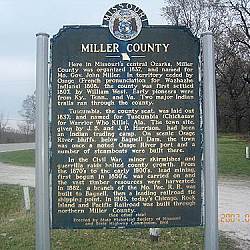
01 Miller County History Sign - Front
|
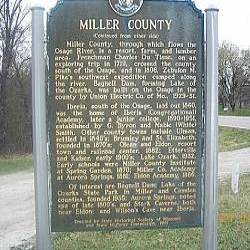
02 Miller County History Sign - Back
|
Click images above for larger view |
The park and sign were placed there in 1961 by the Missouri State Historical Society and the State Highway Commission. I was told by Bamber Wright, who at the time lived across the road from the sign, that the idea for placing a sign there first was suggested by Harley Vaughan, who was an employee of the State Highway Department. The owner of the property was Byron Hix, who graciously donated the piece of land for the project.
Many times over the last few years having noticed that quite a few cars were stopping there I would think to myself, “How nice that so many people are interested in our county history!” But then my wife told me more likely they were stopping there because that was the last place you could receive a cell phone tower signal before descending down the hill toward Tuscumbia. What a disappointing idea!
At any rate I am using the history from the sign for presentation to small groups and accompanying it with pertinent photographs from our files. Sometimes it is difficult to decide which photograph is most appropriate for a particular part of the narrative, especially when you need to keep the presentation within a confined time frame. What I can do though is to change the photographs each time I give the presentation; maybe that way I can discover which prove to be the most interesting to the audience.
So then, let’s begin this abbreviated history of Miller County. In parentheses I will place additional ad lib commentary I make from time to time to place in context the relationship of the photo to the narrative.
Miller County History
Here in this house in Missouri’s central Ozarks (photo 03), once owned by early settler William Miller (photo 03a), Miller County was organized in 1837, and named for Missouri's Governor John Miller, a distant cousin of William.
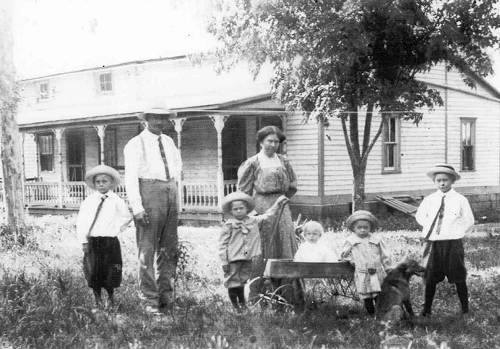
03 Tellman Home Before 2nd Addition - 1916
Left to Right: William, Charles, Leonard, Josephine, Edwin, Harold and Frank
(This photo is of the Charles Tellman home, which was built around the old log cabin where William Miller and others organized the county charter in 1837. About twenty years ago the home unfortunately burned. The property is now owned by the Missouri Conservation Department. You can read more about Charles Tellman and the home at this previous edition of Progress Notes.
You will need to scroll half way down the page to reach the part about the Tellman family as told by Cyrilla Tellman Doerhoff, daughter of Charles Tellman.)
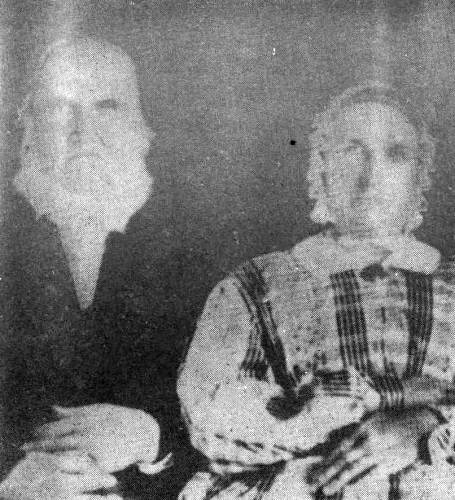
03a William and Sarah Miller
In territory ceded by the Osage (French pronunciation for Wazhazhe Indians) Indians in 1808 (photo 04), the county was first settled 1807, by William West.
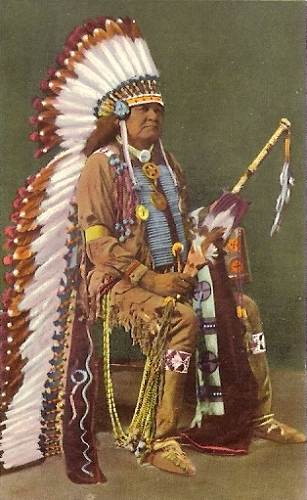
04 Indian Chief in Full Dress
Early pioneers were from Kentucky, Tennessee, and Virginia. Two major Indian trails ran through the county (photo 05).
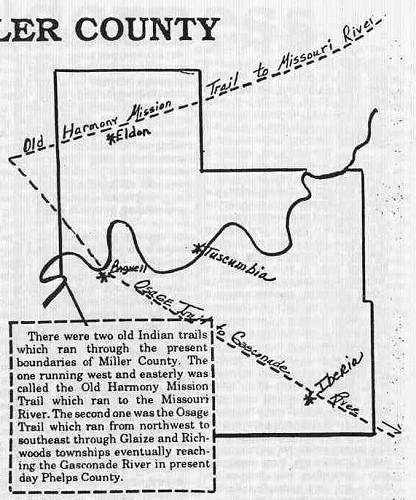
05 Indian Trails
Click image for larger view
Tuscumbia (photo 06), the county seat (photos 07 and 08), was laid out in 1837, and named for Tuscumbia (Chickasaw for Warrior who Kills), Alabama.
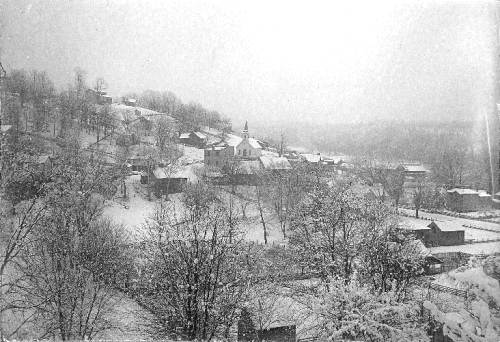
06 Tuscumbia In Winter
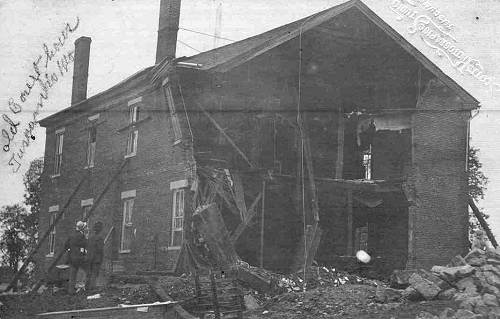
07 Second Courthouse Being Remodeled - 1909
Click image for larger view
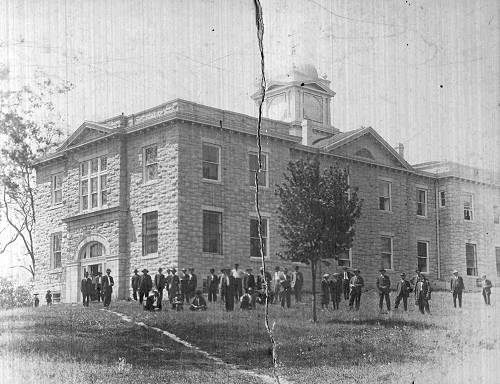
08 Opening of Remodeled Courthouse - 1910
Click image for larger view
(The photo 7 of the courthouse being “remodeled” really was more than remodeling. The County Court, upset that the citizens would not vote a bond for a new courthouse, used the euphemism of “remodeling” when in actuality, what was intended and what was accomplished was the construction of a completely new building around the old one as depicted in photo 8.)
The town site, given by J.B. and J.P. Harrison, had been an Indian trading camp. On scenic Osage River bluffs, below Bagnell Dam, the town was once a noted Osage River port and a number of steamboats were built there (photo 09).
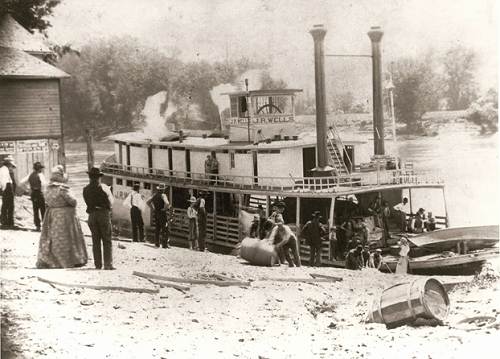
09 J.R. Wells unloading at Tuscumbia
A ferry crossed the Osage River there (photo 10).
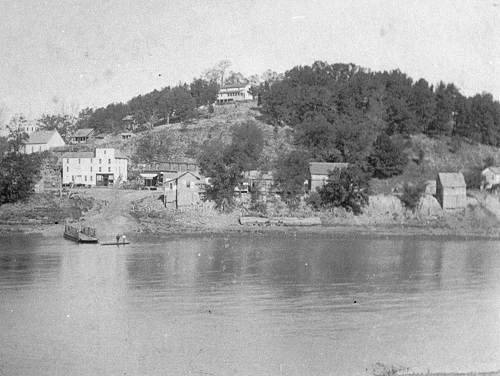
10 Ferry Landing at Tuscumbia
In the Civil War, minor skirmishes and guerilla raids halted county growth (photo 11).
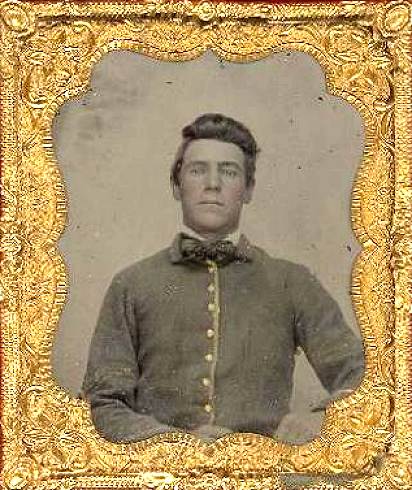
11 Andrew Bear
(This photo is of Andrew Bear who fought for the North and was a great great uncle of mine. Andrew’s grandson, Roy Bear, who was a graduate of Tuscumbia High School, passed away just last year).
From the 1870’s to the early 1900’s, lead mining, first begun in the 1850’s, was carried on and the vast timber resources were harvested. In 1882, a branch of the Missouri Pacific Railroad was built from Eldon to Bagnell, then a leading railroad tie shipping point (photos 12, 13 and 13a).
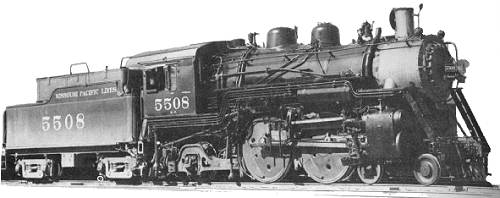
12 Missouri Pacific Engine
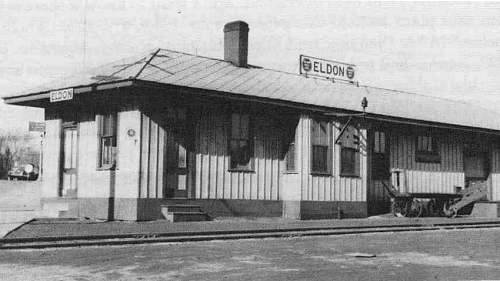
13 Missouri Pacific Station
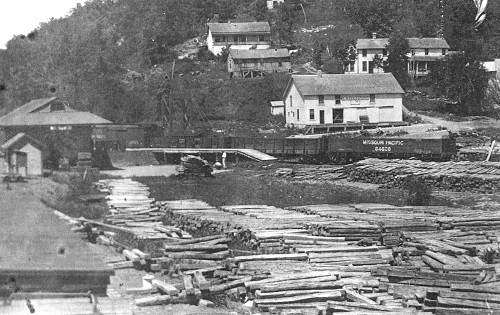
13a Bagnell Tie Yard
In 1903, today’s Chicago, Rock Island and Pacific Railroad was built through northern Miller County (photos 14 and 15).
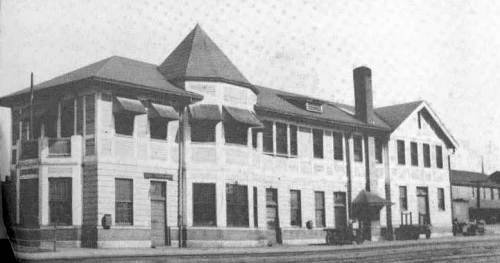
14 Rock Island Station in Eldon
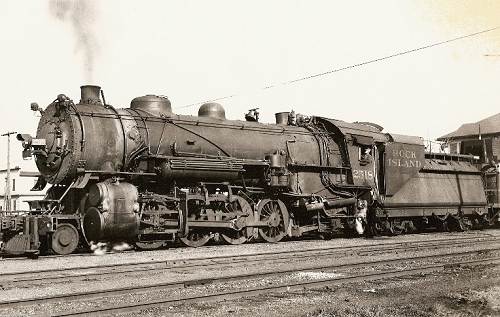
15 Rock Island Engine
(You can read about the history of Miller County railroads in this previous edition of Progress Notes.)
Miller County, through which flows the Osage River, is a resort, farm, and lumber area. Frenchman Charles Du Tisne, on an exploring trip in 1719, crossed the county south of the Osage (photo 16), and in 1806, Zebulon Montgomery Pike’s (photo 16a) southwest expedition camped along the river (photo 17).
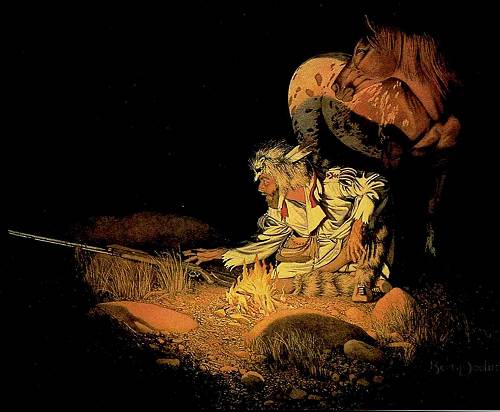
16 French Trapper and Hunter
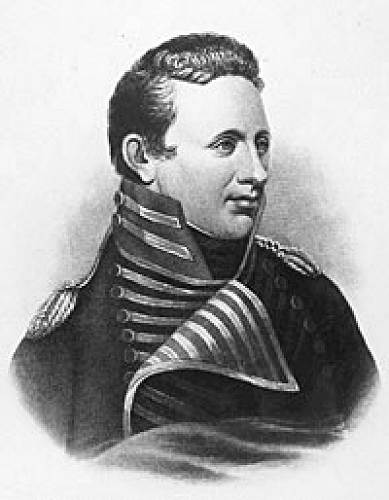
16a Zebulon Montgomery Pike
(You can read more about Zebulon M. Pike at the Pike National Trail Assoication website and more specifically about his travels through Missouri there as well.)
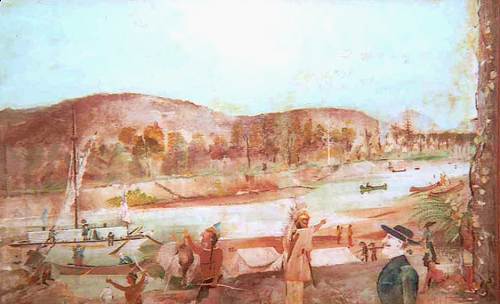
17 Pike's Landing at Tuscumbia
(Note: The painting shown above is by John Wright, famous Miller County artist of the early part of the last century. You can read more about John in this previous edition of Progress Notes.)
Bagnell Dam, forming Lake of the Ozarks, was built on the Osage in the county by Union Electric Company of Missouri, 1929-1931 (photo 18).
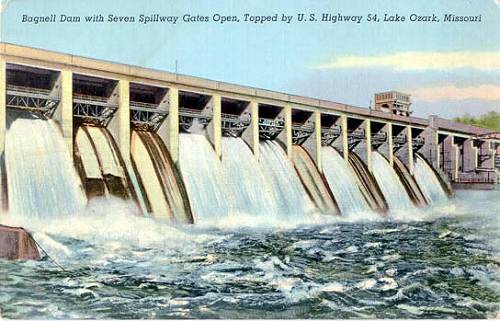
18 Bagnell Dam
(Note: We have at our museum the largest pictorial historical display of the construction of Bagnell Dam that you will find anywhere. It was donated to us by Union Electric Company quite a few years ago and is located on the entire ninety foot long west wall of the lower level of our museum.)
Iberia, south of the Osage River, laid out in 1860, was the home of Iberia (Congregational) Academy, later a junior college, 1890-1951, established by G. Byron and Mable (White) Smith (photo 19).
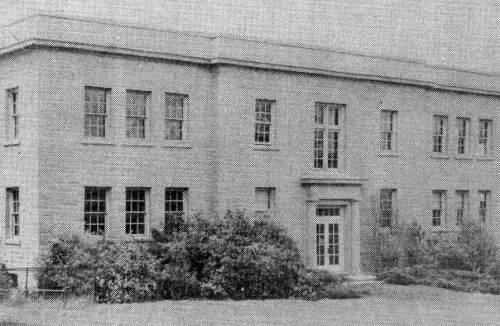
19 Iberia Academy Classroom Building
(Another museum display we have which is quite detailed and informative is the one featuring the history of the Iberia Academy.)
Other county towns include Ulman, settled in the 1840’s named for Joseph Ulman (photo 20);
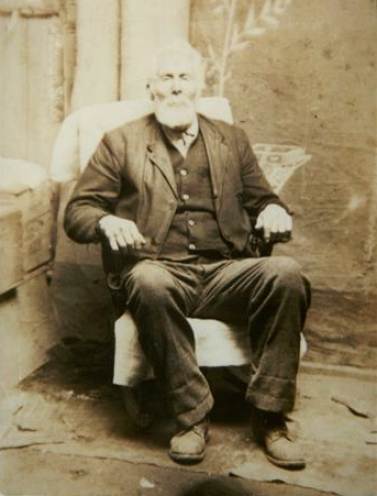
20 Dr. Joseph Ulman
Brumley, known for its swinging bridges (photo 21) and St. Elizabeth, known for its beautiful church (photo 22), founded in the 1870’s;
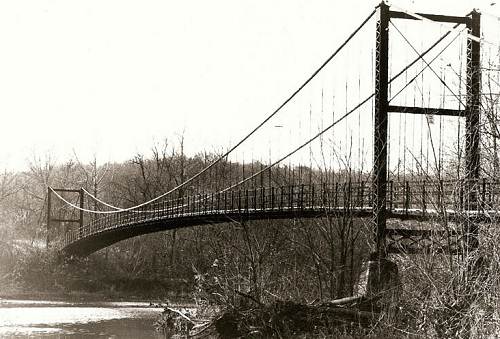
21 Auglaize Bridge

22 St. Lawrence Church
Olean, home to one of Miller County’s most famous citizens, Dr. W.S. Allee (photo 23), and Eldon, resort town and railroad center first plotted by George Weeks (photo 24), 1882;
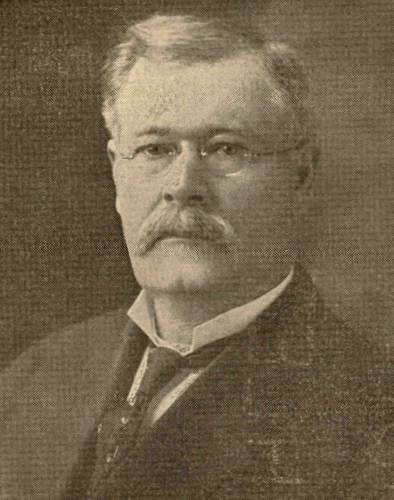
23 Dr. W. S. Allee
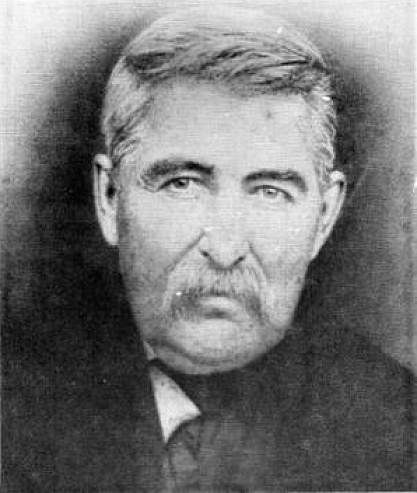
24 George Weeks
Etterville which had a train station (photo 25) and Kaiser (photo 26), early 1900’s;
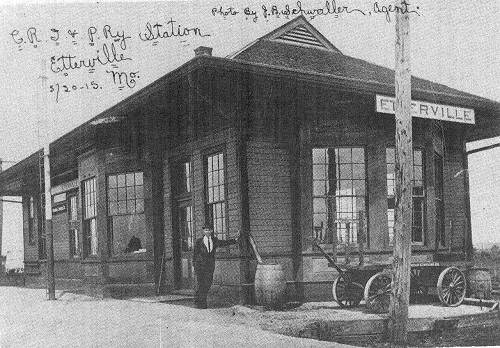
25 Rock Island Depot
Click image for larger view
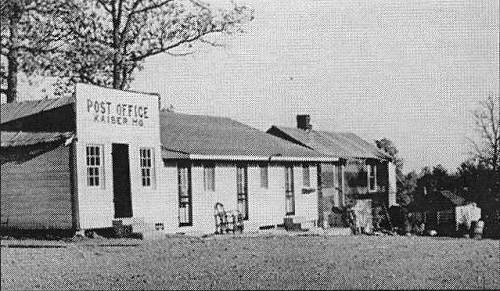
26 Kaiser Post Office - Circa 1936
Lake Ozark (photo 27), 1932.
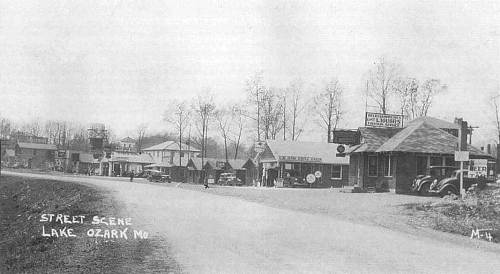
27 Lake Ozark Strip - 1933
Click image for larger view
Early schools were Miller County Institute at Spring Garden, 1870 (photo 28);
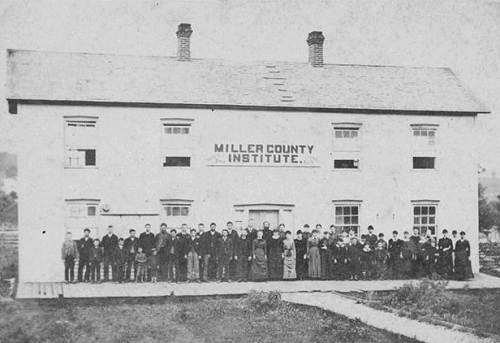
28 Miller County Institute Group Photo
Click image for larger view
Miller County Academy at Aurora Springs, 1881; Eldon Academy 1886 (photo 29).
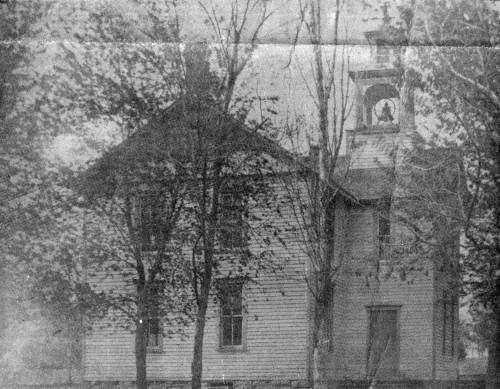
29 Early Eldon School on S. Grand Ave.
(You can read more about each of the above named communities by going to the top of our Home page and click on the section named “Communities.”)
Of interest are Bagnell Dam (photo 30);

30 Bagnell Dam
Lake of the Ozarks State Park in Miller and Camden counties, founded 1935; Aurora Springs, noted spa of the late 1800’s (photo 31), and Stark Caverns (photo 32), both near Eldon;
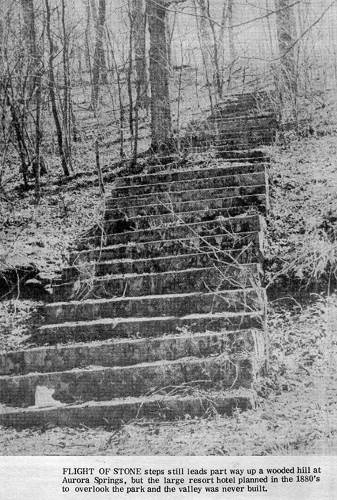
31 Aurora Springs steps to Hotel
Click image for larger view
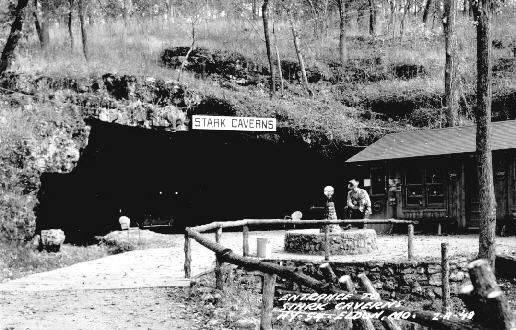
32 Stark Caverns
and Wilson’s Cave (photo 33) near Iberia.
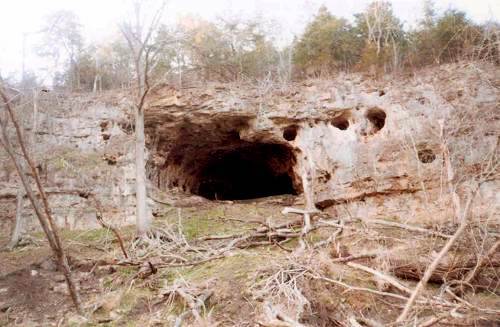
33 Wilson's Cave
(Another way of finding more information about each of the above listed items of interest in Miller County is to use the “Site Search” tool. You can locate “Site Search” by clicking on the “About Us” box at the top of our home page on the far left and typing in the subject you want to research. It is best if you only type in one word for what you want to look up.)
Recently the museum received a book from descendents of James C. Colvin entitled Wet Glaize Ambush which tells the story of the ambush and killing of Judge James Carlee Colvin, a very well respected and liked Miller County resident of the early part of the last century. Here is a synopsis of information regarding the book (photo 34).
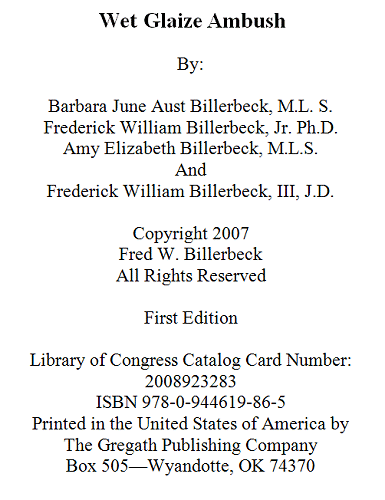
34 "Wet Glaize Ambush" Book Information
The Colvin family was very well known at the time with most members living in the Kaiser area near where the Colvin Cemetery is located. One of the reasons I was interested in the story of this shooting is that Judge Colvin and my wife’s grandmother, Maggie McDaniel Boyd, shared the same grandfather, James Hamilton Colvin, although through two different grandmothers since James Hamilton Colvin had married twice. The poignant story of George McDaniel and his wife, Ann Liza Colvin (parents of Maggie), is told in a previous Progress Notes.
To summarize the McDaniel/Colvin relationship I will paraphrase a section of the narrative from the above website:
George Washington McDaniel, child of John and Elizabeth Henderson McDaniel, married Ann Liza Colvin on July 13, 1886. Ann Liza was the second child of James Hamilton and Mary Elizabeth Shoemaker Roark Colvin. (However, she was the twelfth child of James H. as he had other children with his first wife, Barbara Phipps). George was 28 and Ann Liza was 15 the day of the marriage. George had come from Greene County, Illinois at age 14 (when his father died) to Des Moines, Iowa (where lived his mother) to Bates County, Missouri (where his older brother Jim lived) to Miller County, Missouri. He first settled in Old Bagnell where he operated a barber shop and a hotel. He cleaned and farmed several tracts of land before he settled on a farm in the Bear Creek community near Kaiser, Missouri where he spent the rest of his life.
The farm George bought had belonged to James Hamilton Colvin, George’s father-in-law. When James Hamilton died, his wife, Mary Elizabeth, divided the farm between their boys Dave, Ike and Allen. Dave was about to lose his part of the family homestead so George bought it and later bought forty more acres from a Mr. Jackson.
So the way the family relationship between the Colvins’ and McDaniels’ works out is as follows:
James Hamilton Colvin with his first wife, Barbara Phipps, was a father to Sterling Maynard Colvin and grandfather to James C. Colvin, son of Sterling Maynard Colvin.
James Hamilton Colvin with his second wife, Mary Elizabeth Shoemaker Roark, was a father to Ann Liza Colvin who later married George McDaniel.
Ann Liza was a half sister to Sterling Maynard Colvin who was the father of James C. Colvin. Ann Liza Colvin McDaniel’s daughter, Maggie, would have been a half first cousin to James C. Colvin.
Ann Liza was a half aunt to James C. Colvin and he and Maggie McDaniel Boyd (daughter of Ann Liza) were half first cousins.
For those who are interested, Nancy Thompson, our museum director, has researched the James Hamilton Colvin family tree.
Here is a photo of Judge Colvin and his family (photo 35):
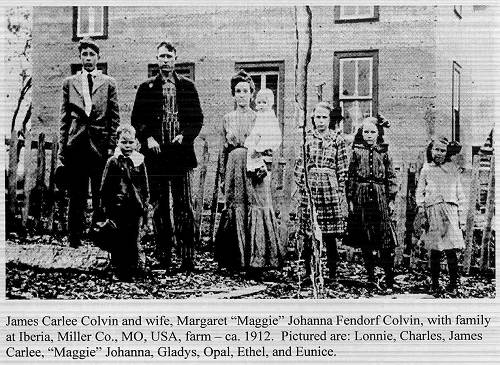
35 James C. Colvin Family
Click image for larger view
And here are separate photos of him and his wife, Maggie Johanna Fendorf Colvin (photos 36 and 37):
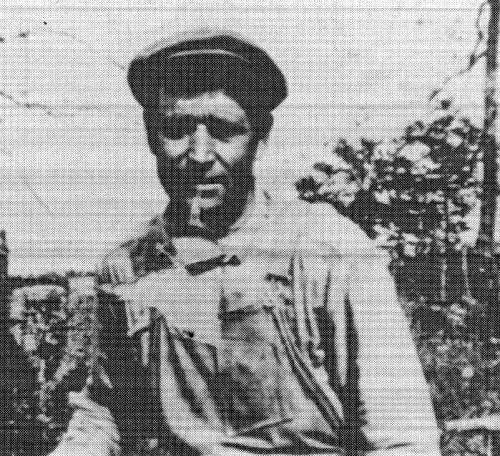
36 Judge James C. Colvin
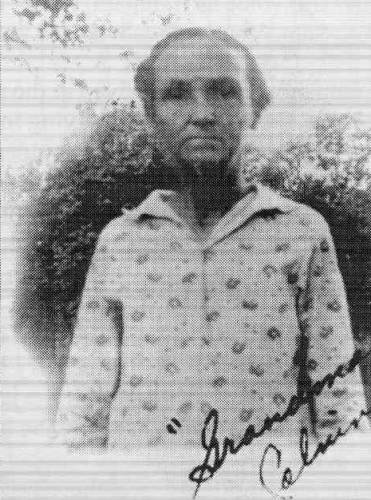
37 Maggie Johanna Fendorf Colvin - 1935
The shooting death of the very well liked and respected Judge Colvin caused quite a public outcry in Miller County at the time and the local newspapers carried several stories documenting the investigation and subsequent trial. I am copying here a couple of the stories and the obituary of Judge Colvin:
Tuscumbia Autogram
11 October 1934
“Judge Colvin Shot to Death From Ambush, Former Member of Miller County Court Found Dead by Neighbors Who Were Attracted by Shots and Noise Early Saturday Morning; Tragedy Occurred on McCracken Farm; Sam McCracken, a Neighbor, Charged With Crime!”
A quarrel of six month duration between two Camden county farmers ended in a tragedy Saturday morning when Judge James C. Colvin was shot and killed, and Sam McCracken, a neighbor is blamed with the crime.
The trouble came up over the rental of the McCracken farm, according to the most authentic information available. Judge Colvin, who had formerly lived in Miller County and served here as a Judge of the Second District two terms, 1923 to 1927, had recently moved over into Camden County, he having rented the McCracken farm, located just across Glaize Creek from Glaize City, Miller Township, Camden County, Mo. USA. This was one of the best farms in the district. McCracken had paid a big price for the farm, so it is said, and had to finally relinquish the place to the mortgage holder. Judge Colvin, it is said rented the farm from the new owner, but McCracken refused to give possession of the home.
Colvin unable to obtain peaceable possession of the residence, moved into a smaller building on the farm, and tended a crop there this year. Colvin was very industrious and on Saturday morning, as was his custom on many mornings, went to work early with instructions to other members of the family to bring the team to the field later, as they were hauling out fodder.
When he went to the corn field he saw a sack beside the shocks, and as he had not put it there, he was curious to know what it contained, since it appeared to be filled with corn. It was filled with corn. It was at this juncture that he was fired on. A shot and a noise as though someone was calling were heard by Buel Winfrey, a nearby farmer. Two or three more shots were heard by him and a neighbor, and since it was known by them that McCracken and Colvin had been quarreling they feared for the worst. They ran to the scene and found that Judge Colvin had expired. Apparently he had crawled about twenty feet from where he was standing when shot for the first time. Portions of his face and arm had been shot away.
McCracken, the previous day, had purchased six shot gun shells at Richland which were loaded with bb shot, and the body gave evidence that such shot had been used.
Sheriff Eidson of Camden County arrested McCracken near Montreal three hours after the shooting. When accused of the crime, and asked why he did it he replied, “I had to.” On the other hand those who examined Colvin’s clothing declare that Colvin had no weapons; that the only articles found in his pockets were a pocket book, a closed knife and some tobacco. McCracken was taken to jail at Camdenton, and a charge of first degree murder has been filed against him.
Judge Colvin was well known throughout Miller County, and had lived most of his life near Brumley, being a farmer by occupation. He was 57 years of age and had spent all his life on a farm. He is survived by his wife and eight children.
Funeral services were conducted at Mt. Union Church, near Brumley, Sunday afternoon by Reverend V.M. Smith, midst a large crowd of sorrowing relatives and friends.
Tuscumbia Autogram
11 October 1934
Obituary
James C. Colvin
James C. Colvin was born near Kaiser, Miller County Mo. USA, March 4, 1877; passed away at his home near Toronto, Mo. October 6, 1934, at the age of 57 years, 5 months and 2 days old at his death.
He was married to Maggie Fendorf about 38 years ago and to this union was born 13 children; 10 are living, 3 have preceded him in death. Those living are Lonnie Colvin of Hawkeye, Charley Colvin of Crescent, Sterling and Noel at home, Opal Pemberton of Crescent, Ethel Pemberton of Pueblo, Colorado, Eunice Pope of Mt. Vernon, Gladys Pemberton of Iberia and Victoria and Geneva at home. Those who have preceded him in death are Ralph and Gensse and one infant. He leaves 2 sisters; Lucy Allee of Brumley, Mary Frakes, who lives in Kansas, one brother Maynard Colvin, also of Kansas. Besides these he leaves hi immediate family and many friends and relatives.
He was judge of the Miller County court and served 2 terms; and made a splendid record in this office.
He was a member of the Church of Christ, Mt. Union congregation. The writer was called to speak words of comfort to the sorrowing relatives and friends, and had an opportunity of speaking to the largest crowd I have ever witnessed on a funeral occasion. The crowd was estimated to be between 600 and 800 people.
Song services were leg by Brother James A. Foster of Camdenton, being assisted by his wife, some folks with them and brethren from Glover Chapel, Oak View, Freedom, Mt. Union, Alder Springs, who did their parts well.
Brother O.A. Mallow of Belle led in prayer, after the writer had spoken words of comfort to sorrowing relatives and friends, the fleshy body was laid in the silent city of the dead to await the judgment morning
V.M. Smith
Tuscumbia Autogram
05 October 1937
Must Serve Life Term For Murder of Judge Colvin
“Supreme Court Affirms Sentenced Imposed on Sam McCracken By Lower Court”
A life sentence given Sam McCracken, Camden County farmer, for killing his neighbor and tenant, Judge J.C. Colvin, on October 6, 1934, was affirmed Friday by the State Supreme Court at Jefferson City.
Judge Colvin, who served in Miller County two terms, 1923 to 1927, inclusive, as Judge of the County Court from the Second District, was shot to death following a quarrel of six months duration.
The trouble came up over the rental of the McCracken farm, which Judge Colvin was cropping. McCracken, who had paid a big price for the farm, had lost the farm by foreclosure, and the place had been rented from the new owner, but McCracken refused to give Colvin possession of the house.
Judge Colvin, being unable to get peaceable possession of the residence, had moved into a small building on the farm.
He was gathering corn and had gone to the field early in the morning to shuck some corn. His attention was attracted by a sack of corn beside a shock, which he had not placed there. He was investigating the sack, when McCracken shot from ambush. Apparently, he had crawled about 10 feet after being shot. Portions of his face and arm had been shot away. He had expired by the time neighbors, who heard the shot, had reached the scene.
McCracken, when accused of the crime following his arrest by Sheriff Eidson, declared he “had to kill Colvin.” McCracken was reputed to have an ill temper and possessed of a quarrelsome and contentious nature.
The higher court now says that McCracken must serve the lifetime sentence.
(Note: Sam McCracken was confined to the Missouri State Penitentiary at Jefferson City, Cole County Missouri, where he spent eighteen years and six months and died on 11 March 1954, of cardiac vascular disease. He was embalmed and buried in the Rolla Cemetery, Rolla, Phelps County Missouri burial plot.)
Last Monday we had the pleasure of a personal visit by Lynn Morrow, Director of the Missouri State Archives located at the office of the Missouri Secretary of State. Lynn came to the museum to receive some historical records of a number of the one room schools which commonly were located in our county years ago. He was assisted by John Korasick who is on the staff of the Archival division having expertise in converting records to microfilm or to digitalized storage devices (photo 38).
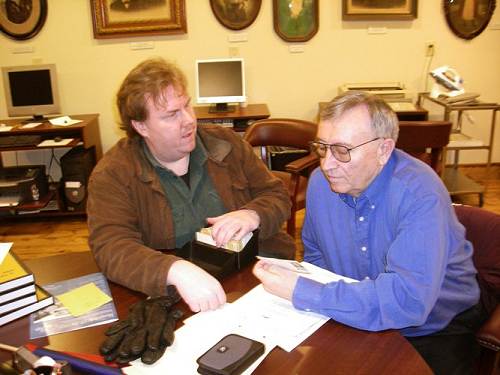
38 John Korasick and Lynn Morrow
Lynn has deep roots in Miller County and has written historical articles about his Morrow ancestors. I featured some of his work in the Progress Notes edition of September 8, 2008.
You will need to scroll down the page half way to get to the section about Lynn. We appreciate the time and support Lynn and his department are giving us to help preserve our historical records.
Also, we were very appreciative of the work Jack Wiggins and Brice Kallenbach have been doing recently on our Monday volunteer work days (photos 39 and 40).

39 Jack Wiggins
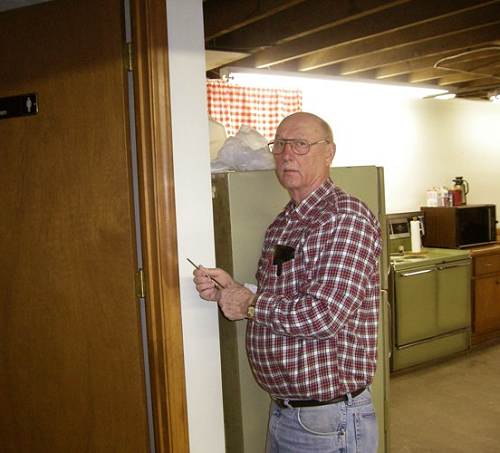
40 Brice Kallenbach
Jack and Brice recently painted the walls of the basement of the original part of our museum building. We appreciate the efforts of those who volunteer their service and skills to help us maintain our museum.
That's all for this week.
|



